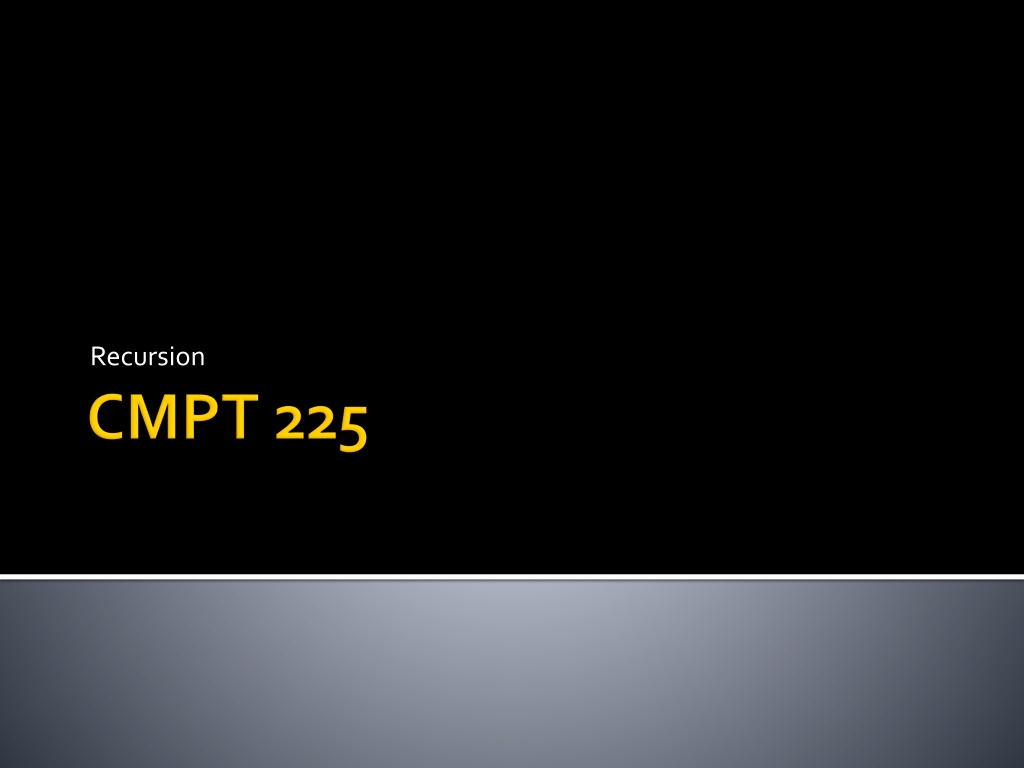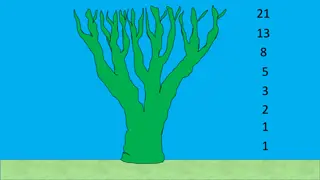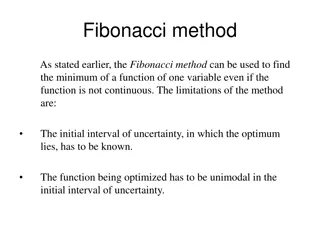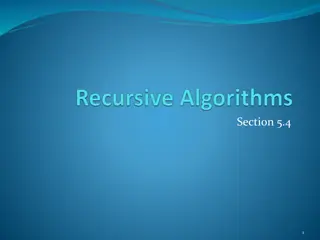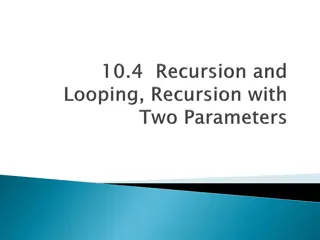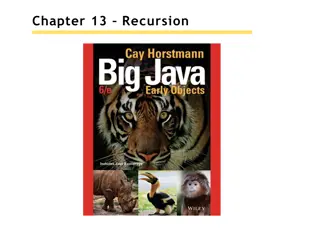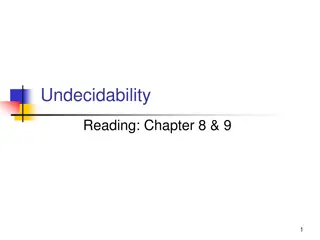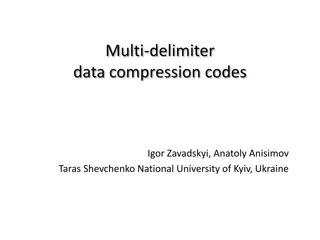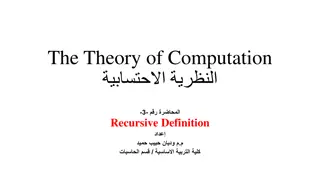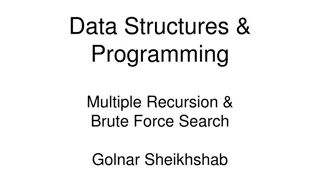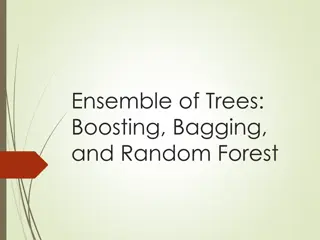Recursive Algorithms for Fibonacci Series
The Fibonacci series, generated through recursive algorithms, explores the growth pattern of pairs of rabbits in a field. By understanding the drawbacks of recursion and analyzing simple recursive algorithms, we delve into the essence of Fibonacci numbers. Discover how the series evolves each month as the rabbits multiply. Explore the recursive approach to calculating Fibonacci numbers in C++, highlighting the self-calling function. Uncover the beauty and complexity of recursive computations reflected in the Fibonacci sequence.
Download Presentation

Please find below an Image/Link to download the presentation.
The content on the website is provided AS IS for your information and personal use only. It may not be sold, licensed, or shared on other websites without obtaining consent from the author.If you encounter any issues during the download, it is possible that the publisher has removed the file from their server.
You are allowed to download the files provided on this website for personal or commercial use, subject to the condition that they are used lawfully. All files are the property of their respective owners.
The content on the website is provided AS IS for your information and personal use only. It may not be sold, licensed, or shared on other websites without obtaining consent from the author.
E N D
Presentation Transcript
Understand how the Fibonacci series is generated Recursive Algorithms Write simple recursive algorithms Analyze simple recursive algorithms Understand the drawbacks of recursion Name other recursive algorithms and data structures John Edgar 2
What happens if you put a pair of rabbits in a field? More rabbits! Assume that rabbits take one month to reach maturity and that Each pair of rabbits produces another pair of rabbits one month after mating. John Edgar 3
How many pairs of rabbits are there after 5 months? Month 1: start 1 Month 2: the rabbits are now mature and can mate 1 Month 3: the first pair give birth to two babies 2 Month 4: the first pair give birth to 2 babies, the pair born in month 3 are now mature 3 Month 5: the 3 pairs from month 4, and 2 new pairs 5 John Edgar 4
month: month: 1 1 2 2 3 3 4 4 5 5 6 6 After 5 months there are 5 pairs of rabbits i.e. the number of pairs at 4 months (3) plus the number of pairs at 3 months (2) Why? While there are 3 pairs of bunnies in month 4 only 2 of them are able to mate the ones alive in month 3 This series of numbers is called the Fibonacci series pairs: pairs: 1 1 1 1 2 2 3 3 5 5 8 8 John Edgar 5
The nth number in the Fibonacci series, fib(n), is: 0 if n = 0, and 1 if n = 1 fib(n 1) + fib(n 2) for any n > 1 e.g. what is fib(23) Easy if we only knew fib(22) and fib(21) The answer is fib(22) + fib(21) What happens if we actually write a function to calculate Fibonacci numbers like this? John Edgar 6
C++ Let's write a function just like the formula fib(n) = 0 if n = 0, 1 if n = 1, otherwise fib(n) = fib(n 1) + fib(n 2) int fib(int n){ if(n == 0 || n == 1){ return n; }else{ return fib(n-1) + fib(n-2); } } The function calls itself John Edgar 7
The Fibonacci function is recursive A recursive function calls itself Each call to a recursive method results in a separate call to the method, with its own input Recursive functions are just like other functions The invocation is pushed onto the call stack And removed from the call stack when the end of a method or a return statement is reached Execution returns to the previous method call John Edgar 8
int fib(int n) if(n == 0 || n == 1) return n; else return fib(n-1) + fib(n-2); } { 5 fib(5) 2 3 fib(3) fib(4) 1 1 2 1 fib(3) fib(2) fib(2) fib(1) 1 1 1 0 1 0 fib(2) fib(1) fib(1) fib(0) fib(1) fib(0) 1 0 fib(1) fib(0) John Edgar 9
When a function is called it is pushed onto the call stack This applies to each invocation of that function When a recursive call is made execution switches to that method call The call stack records the line number of the previous method where the call was made from Once a method call execution finishes, returns to the previous invocation John Edgar 10
January 2010 Greg Mori 11
Recursive functions do not use loops to repeat instructions But use recursive calls, in if statements Recursive functions consist of two or more cases, there must be at least one Base case, and one Recursive case John Edgar 12
The base case is a smaller problem with a simpler solution This problem s solution must not be recursive Otherwise the function may never terminate There can be more than one base case John Edgar 13
The recursive case is the same problem with smaller input The recursive case must include a recursive function call There can be more than one recursive case John Edgar 14
Define the problem in terms of a smaller problem of the same type The recursive part e.g. return fib(n-1) + fib(n-2); And the base case where the solution can be easily calculated This solution should not be recursive e.g. if (n == 0 || n == 1) return n; John Edgar 15
How can the problem be defined in terms of smaller problems of the same type? By how much does each recursive call reduce the problem size? By 1, by half, ? What are the base cases that can be solved without recursion? Will a base case be reached as the problem size is reduced? John Edgar 16
January 2010 Greg Mori 17
Linear Search Binary Search Assume sorted array John Edgar 18
C++ int linSearch(int *arr, int n, int x){ for (int i=0; i < n; i++){ if(x == arr[i]){ return i; } } //for return -1; //target not found } The algorithm searches the array one element at a time using a for loop John Edgar 19
Base cases Target is found at first position in array The end of the array is reached Recursive case Target not found at first position Search again, discarding the first element of the array John Edgar 20
C++ int linSearch(int *arr, int n, int x){ return recLinSearch(arr,n,0,x); } int recLinSearch(int *arr, int n, int i, int x){ if (i >= n){ return -1; } else if (x == arr[i]){ return i; } else return recLinSearch(arr, n, i + 1, x); } } John Edgar 21
Of course, if its a sorted array we wouldnt do linear search John Edgar 22
Each sub-problem searches a subarray Differs only in the upper and lower array indices that define the subarray Each sub-problem is smaller than the last one In the case of binary search, half the size There are two base cases When the target item is found and When the problem space consists of one item Make sure that this last item is checked John Edgar 23
C++ int binSearch(int *arr, int lower, int upper, int x){ int mid = (lower + upper) / 2; if (lower > upper){ return - 1; //base case } else if(arr[mid] == x){ return mid; //second base case } else if(arr[mid] < x){ return binSearch(arr, mid + 1, upper, x); } else { //arr[mid] > target return binSearch(arr, lower, mid - 1, x); } } John Edgar 24
January 2010 Greg Mori 25
Merge Sort Quicksort John Edgar 26
January 2010 Greg Mori 27
Whats the easiest list to sort? A list of 1 number John Edgar 28
Lets say I have 2 sorted lists of numbers How can I merge them into 1 sorted list? 1 12 22 23 3 5 42 99 List 1 List 2 1 3 5 12 22 23 42 99 output John Edgar 29
If I have a list of n numbers, how should I sort them? I know two things How to sort a list of 1 number How to merge 2 sorted lists of numbers into 1 sorted list Smells like recursion John Edgar 30
mergeSort (array) if (array is length 1) // base case, one element return the array else arr1 = mergeSort(first half of array) arr2 = mergeSort(second half of array) return merge(arr1,arr2) John Edgar 31
What is the time complexity of a merge? 1 12 22 23 3 5 42 99 List 1 List 2 1 3 5 12 22 23 42 99 output John Edgar 32
How many recursive steps are there? How large are the merges at each recursive step? Merge takes O(n) time for n elements John Edgar 33
23 07 41 11 33 19 81 23 07 33 19 41 11 45 45 81 Sort entire array Sorted entire array 23 23 41 33 33 41 81 81 07 07 19 11 11 19 45 45 Sort halves Sorted halves 23 23 41 41 33 33 81 81 07 07 19 19 11 11 45 45 Sort quarters Sorted quarters 23 41 33 81 07 19 11 45 Sort eighths John Edgar 34
23 41 33 81 07 19 11 45 Sort entire array 23 41 33 81 07 19 11 45 Sort halves 23 41 33 81 07 19 11 45 Sort quarters 23 41 33 81 07 19 11 45 Sort eighths How many recursive steps are there? How large are the merges at each recursive step? Merge takes O(n) time for n elements John Edgar 35
23 41 33 81 07 19 11 45 Sort entire array 23 41 33 81 07 19 11 45 Sort halves 23 41 33 81 07 19 11 45 Sort quarters 23 41 33 81 07 19 11 45 Sort eighths How many recursive steps are there? O(log n) steps: split array in half each time How large are the merges at each recursive step? In total, merge n elements each step Time complexity is O(n log n) John Edgar 36
Mergesort Best case: O(n(log2n)) Average case: O(n(log2n)) Worst case: O(n(log2n)) John Edgar 37
Quicksort is a more efficient sorting algorithm than either selection or insertion sort It sorts an array by repeatedly partitioning it We will go over the basic idea of quicksort and an example of it See text / on-line resources for details John Edgar 39
Partitioning is the process of dividing an array into sections (partitions), based on some criteria "Big" and "small" values Negative and positive numbers Names that begin with a-m, names that begin with n-z Darker and lighter pixels Quicksort uses repeated partitioning to sort an array John Edgar 40
Partition this array into small and big values using a partitioning algorithm 31 12 07 23 93 02 11 18 John Edgar 41
Partition this array into small and big values using a partitioning algorithm 31 12 07 23 93 02 11 18 18 We will partition the array around the last value (18), we'll call this value the pivot 18 smalls < 18 smalls < 18 bigs bigs > 18 > 18 pivot pivot John Edgar 42
Partition this array into small and big values using a partitioning algorithm 31 12 07 23 93 02 11 18 We will partition the array around the last value (18), we'll call this value the pivot arr[low ] is greater than the pivot and should be on the right, we need to swap it with something Use two indices, one at each end of the array, call them low and high John Edgar 43
Partition this array into small and big values using a partitioning algorithm 31 12 07 23 93 02 11 18 We will partition the array around the last value (18), we'll call this value the pivot arr[low ] (31) is greater than the pivot and should be on the right, we need to swap it with something Use two indices, one at each end of the array, call them low and high arr[high] (11) is less than the pivot so swap with arr[low ] John Edgar 44
Partition this array into small and big values using a partitioning algorithm 31 12 07 23 93 02 11 18 11 31 We will partition the array around the last value (18), we'll call this value the pivot Use two indices, one at each end of the array, call them low and high John Edgar 45
Partition this array into small and big values using a partitioning algorithm 11 12 07 23 93 02 02 12 07 23 31 18 We will partition the array around the last value (18), we'll call this value the pivot repeat this process until: Use two indices, one at each end of the array, call them low and high John Edgar 46
Partition this array into small and big values using a partitioning algorithm 11 12 07 02 93 23 31 18 We will partition the array around the last value (18), we'll call this value the pivot repeat this process until: high and low are the same Use two indices, one at each end of the array, call them low and high John Edgar 47
Partition this array into small and big values using a partitioning algorithm 11 12 07 02 93 18 23 31 18 93 We will partition the array around the last value (18), we'll call this value the pivot repeat this process until: high and low are the same Use two indices, one at each end of the array, call them low and high We'd like the pivot value to be in the centre of the array, so we will swap it with the first item greater than it John Edgar 48
Partition this array into small and big values using a partitioning algorithm 11 12 07 02 18 23 31 93 smalls smalls bigs bigs pivot pivot We will partition the array around the last value (18), we'll call this value the pivot Use two indices, one at each end of the array, call them low and high John Edgar 49
00 08 07 01 06 02 05 09 Use the same algorithm to partition this array into small and big values 00 08 07 01 06 02 05 09 smalls smalls bigs bigs! ! pivot pivot John Edgar 50
